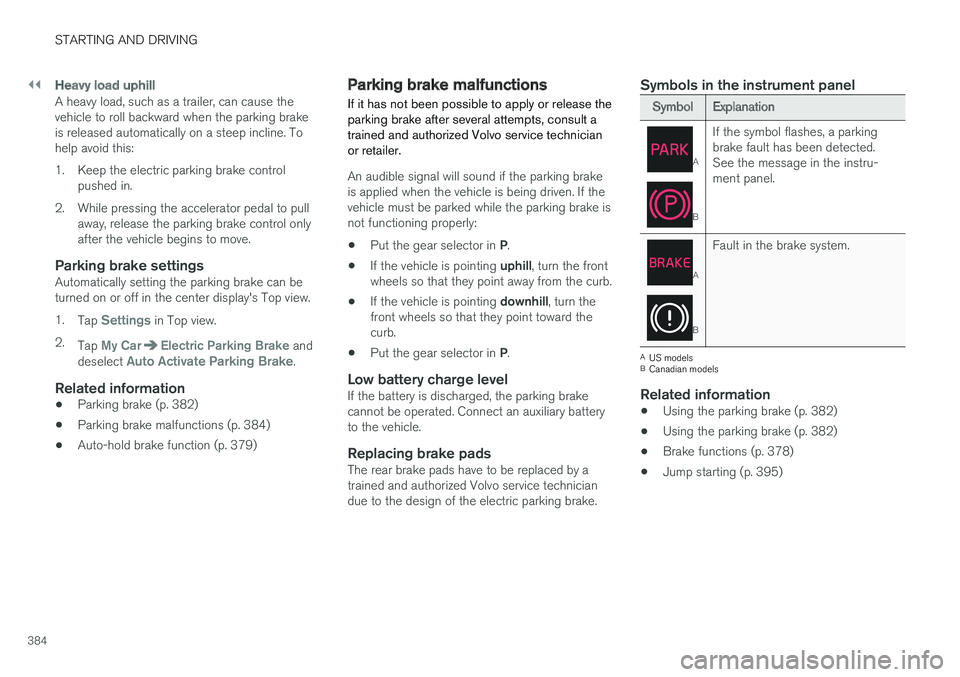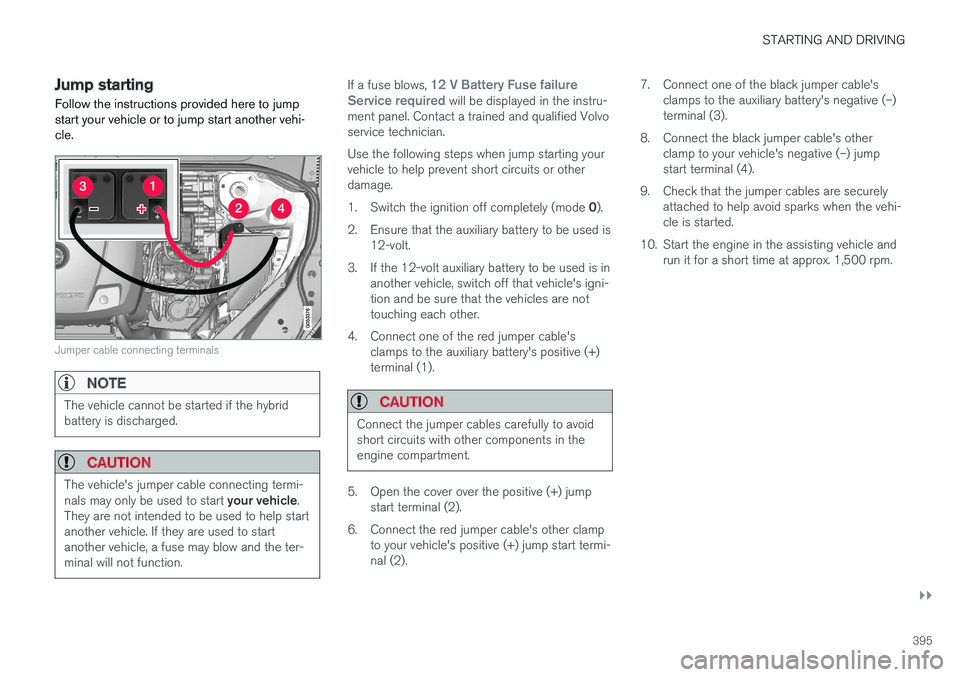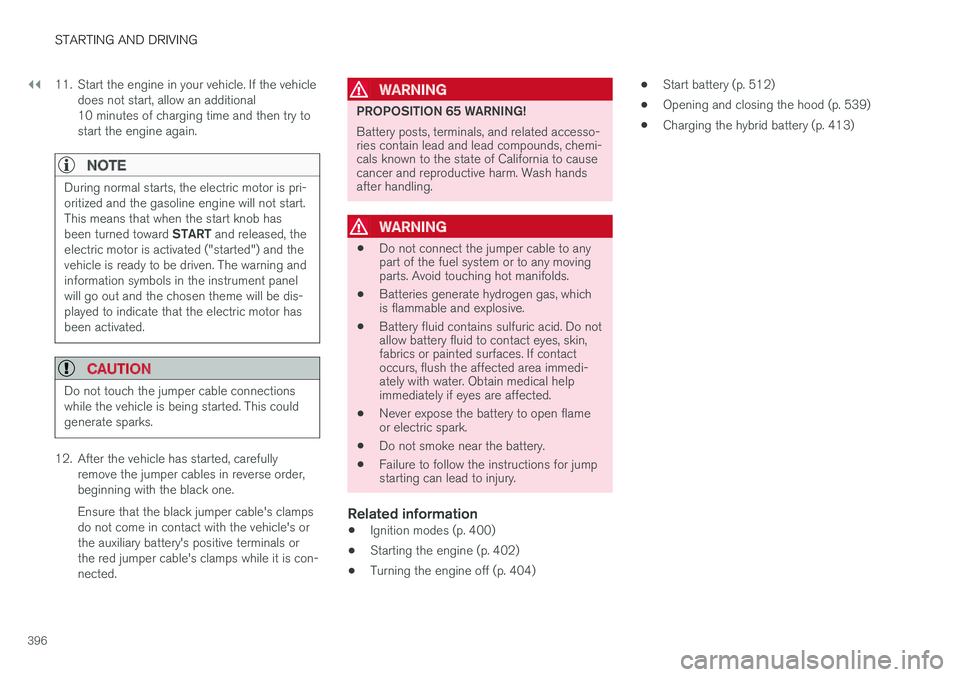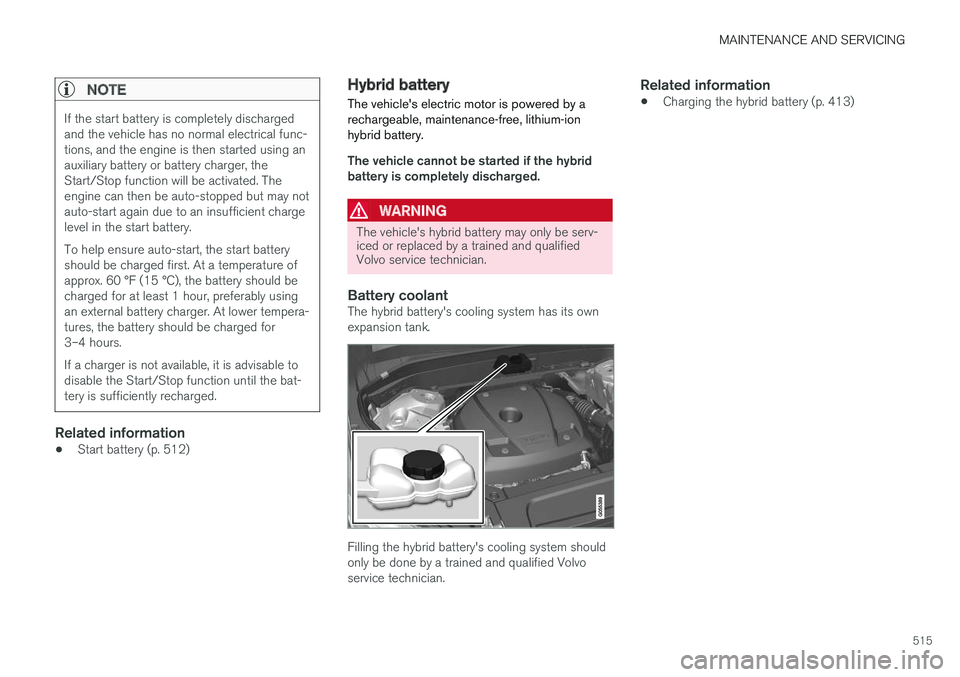auxiliary battery VOLVO XC90 TWIN ENGINE HYBRID 2017 Owners Manual
[x] Cancel search | Manufacturer: VOLVO, Model Year: 2017, Model line: XC90 TWIN ENGINE HYBRID, Model: VOLVO XC90 TWIN ENGINE HYBRID 2017Pages: 584, PDF Size: 14.2 MB
Page 386 of 584

||
STARTING AND DRIVING
384
Heavy load uphill
A heavy load, such as a trailer, can cause thevehicle to roll backward when the parking brakeis released automatically on a steep incline. Tohelp avoid this:
1. Keep the electric parking brake controlpushed in.
2. While pressing the accelerator pedal to pullaway, release the parking brake control onlyafter the vehicle begins to move.
Parking brake settings
Automatically setting the parking brake can beturned on or off in the center display's Top view.
1.Tap Settings in Top view.
2.Tap My CarElectric Parking Brake anddeselect Auto Activate Parking Brake.
Related information
•Parking brake (p. 382)
•Parking brake malfunctions (p. 384)
•Auto-hold brake function (p. 379)
Parking brake malfunctions
If it has not been possible to apply or release theparking brake after several attempts, consult atrained and authorized Volvo service technicianor retailer.
An audible signal will sound if the parking brakeis applied when the vehicle is being driven. If thevehicle must be parked while the parking brake isnot functioning properly:
•Put the gear selector in P.
•If the vehicle is pointing uphill, turn the frontwheels so that they point away from the curb.
•If the vehicle is pointing downhill, turn thefront wheels so that they point toward thecurb.
•Put the gear selector in P.
Low battery charge level
If the battery is discharged, the parking brakecannot be operated. Connect an auxiliary batteryto the vehicle.
Replacing brake pads
The rear brake pads have to be replaced by atrained and authorized Volvo service techniciandue to the design of the electric parking brake.
Symbols in the instrument panel
SymbolExplanation
A
B
If the symbol flashes, a parkingbrake fault has been detected.See the message in the instru-ment panel.
A
B
Fault in the brake system.
AUS modelsBCanadian models
Related information
•Using the parking brake (p. 382)
•Using the parking brake (p. 382)
•Brake functions (p. 378)
•Jump starting (p. 395)
Page 397 of 584

STARTING AND DRIVING
}}
395
Jump starting
Follow the instructions provided here to jumpstart your vehicle or to jump start another vehi-cle.
Jumper cable connecting terminals
NOTE
The vehicle cannot be started if the hybridbattery is discharged.
CAUTION
The vehicle's jumper cable connecting termi-nals may only be used to start your vehicle.They are not intended to be used to help startanother vehicle. If they are used to startanother vehicle, a fuse may blow and the ter-minal will not function.
If a fuse blows, 12 V Battery Fuse failureService required will be displayed in the instru-ment panel. Contact a trained and qualified Volvoservice technician.
Use the following steps when jump starting yourvehicle to help prevent short circuits or otherdamage.
1.Switch the ignition off completely (mode 0).
2.Ensure that the auxiliary battery to be used is12-volt.
3. If the 12-volt auxiliary battery to be used is inanother vehicle, switch off that vehicle's igni-tion and be sure that the vehicles are nottouching each other.
4. Connect one of the red jumper cable'sclamps to the auxiliary battery's positive (+)terminal (1).
CAUTION
Connect the jumper cables carefully to avoidshort circuits with other components in theengine compartment.
5. Open the cover over the positive (+) jumpstart terminal (2).
6.Connect the red jumper cable's other clampto your vehicle's positive (+) jump start termi-nal (2).
7. Connect one of the black jumper cable'sclamps to the auxiliary battery's negative (–)terminal (3).
8. Connect the black jumper cable's otherclamp to your vehicle's negative (–) jumpstart terminal (4).
9. Check that the jumper cables are securelyattached to help avoid sparks when the vehi-cle is started.
10. Start the engine in the assisting vehicle andrun it for a short time at approx. 1,500 rpm.
Page 398 of 584

||
STARTING AND DRIVING
396
11. Start the engine in your vehicle. If the vehicledoes not start, allow an additional10 minutes of charging time and then try tostart the engine again.
NOTE
During normal starts, the electric motor is pri-oritized and the gasoline engine will not start.This means that when the start knob hasbeen turned toward START and released, theelectric motor is activated ("started") and thevehicle is ready to be driven. The warning andinformation symbols in the instrument panelwill go out and the chosen theme will be dis-played to indicate that the electric motor hasbeen activated.
CAUTION
Do not touch the jumper cable connectionswhile the vehicle is being started. This couldgenerate sparks.
12. After the vehicle has started, carefullyremove the jumper cables in reverse order,beginning with the black one.
Ensure that the black jumper cable's clampsdo not come in contact with the vehicle's orthe auxiliary battery's positive terminals orthe red jumper cable's clamps while it is con-nected.
WARNING
PROPOSITION 65 WARNING!
Battery posts, terminals, and related accesso-ries contain lead and lead compounds, chemi-cals known to the state of California to causecancer and reproductive harm. Wash handsafter handling.
WARNING
•Do not connect the jumper cable to anypart of the fuel system or to any movingparts. Avoid touching hot manifolds.
•Batteries generate hydrogen gas, whichis flammable and explosive.
•Battery fluid contains sulfuric acid. Do notallow battery fluid to contact eyes, skin,fabrics or painted surfaces. If contactoccurs, flush the affected area immedi-ately with water. Obtain medical helpimmediately if eyes are affected.
•Never expose the battery to open flameor electric spark.
•Do not smoke near the battery.
•Failure to follow the instructions for jumpstarting can lead to injury.
Related information
•Ignition modes (p. 400)
•Starting the engine (p. 402)
•Turning the engine off (p. 404)
•Start battery (p. 512)
•Opening and closing the hood (p. 539)
•Charging the hybrid battery (p. 413)
Page 517 of 584

MAINTENANCE AND SERVICING
515
NOTE
If the start battery is completely dischargedand the vehicle has no normal electrical func-tions, and the engine is then started using anauxiliary battery or battery charger, theStart/Stop function will be activated. Theengine can then be auto-stopped but may notauto-start again due to an insufficient chargelevel in the start battery.
To help ensure auto-start, the start batteryshould be charged first. At a temperature ofapprox. 60 °F (15 °C), the battery should becharged for at least 1 hour, preferably usingan external battery charger. At lower tempera-tures, the battery should be charged for3–4 hours.
If a charger is not available, it is advisable todisable the Start/Stop function until the bat-tery is sufficiently recharged.
Related information
•Start battery (p. 512)
Hybrid battery
The vehicle's electric motor is powered by arechargeable, maintenance-free, lithium-ionhybrid battery.
The vehicle cannot be started if the hybridbattery is completely discharged.
WARNING
The vehicle's hybrid battery may only be serv-iced or replaced by a trained and qualifiedVolvo service technician.
Battery coolant
The hybrid battery's cooling system has its ownexpansion tank.
Filling the hybrid battery's cooling system shouldonly be done by a trained and qualified Volvoservice technician.
Related information
•Charging the hybrid battery (p. 413)